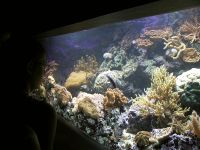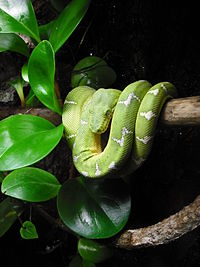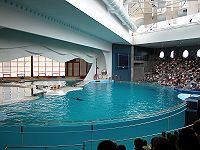- National Aquarium in Baltimore
-
National Aquarium, Baltimore
The National Aquarium, Baltimore (angular building, rear right, and 2005 extension to its left) lies near historic ships in the Inner Harbor area of Baltimore, including USS Torsk and Lightship Chesapeake.Date opened August 8, 1981 Location Baltimore, Maryland, USA Coordinates 39°17′04″N 76°36′25″W / 39.284398°N 76.606936°WCoordinates: 39°17′04″N 76°36′25″W / 39.284398°N 76.606936°W Number of animals 16,500[1] Number of species 660[1] Annual visitors 1.5 million (2009)[2] Memberships AZA[3] Major exhibits Atlantic bottlenose dolphins, Upland Tropical Rain Forest, Australia: Wild Extremes, Jellies Invasion: Oceans Out of Balance, multiple-story Atlantic Coral Reef and Open Ocean shark tank Website http://www.aqua.org The National Aquarium, Baltimore is a public aquarium located at 501 E Pratt St. in the Inner Harbor area of Baltimore, Maryland, USA. It was constructed during Baltimore's urban renewal period and opened on August 8, 1981. The aquarium has an annual attendance of 1.5 million and a collection of 16,500 specimens representing 660 species. Exhibits include the Atlantic bottlenose dolphins, Upland Tropical Rain Forest, Australia: Wild Extremes, Jellies Invasion: Oceans Out of Balance, multiple-story Atlantic Coral Reef and Open Ocean shark tank. In 2011, Coastal Living magazine named it the #1 aquarium in the U.S.
In 2003, separate aquariums in Baltimore, MD, and Washington, DC, joined as one “National Aquarium.” [4]
In November 2006, the National Aquarium won a Best of Baltimore award for "Best Over Priced Destination for Families."[5]
History
The aquarium began in the mid-1970s when then-Mayor William Donald Schaefer and the Commissioner of Housing and Community Development, Robert C. Embry, conceived and championed the idea of an aquarium as a vital component of Baltimore’s overall Inner Harbor redevelopment scheme. In 1976, Baltimore City residents supported the aquarium by voting for it on a bond referendum, and the groundbreaking for the facility took place on Pier 3 in the city’s Inner Harbor on August 8, 1978.
As early as November 1979, the Aquarium’s world-class status was recognized by the United States Congress, which granted the facility “national” status. The National Aquarium, Baltimore opened to the public on August 8, 1981, after three years of construction.
The National Aquarium, Baltimore’s initial conceptual design, architecture and exhibit design was led by Peter Chermayeff of Peter Chermayeff LLC while he was at Cambridge Seven Associates. It measures 115,000 square feet and holds more than 1 million gallons of water.
The conceptual, architectural, and exhibit design for the Glass Pavilion expansion was led by Bobby C. Poole while at Chermayeff, Sollogub & Poole.[6][7] Construction began on the Glass Pavilion on September 5, 2002, and it opened to the public on December 16, 2005. It measures 64,500 square feet, and is 120 feet high at the tallest point.
Relationship with the National Aquarium, Washington, D.C.
The National Aquarium in Washington, D.C. is a separate aquarium housed in the lower level of the Commerce Building in Washington, D.C.. Founded in 1873, it was originally distinct from the National Aquarium in Baltimore. On September 4, 2003, the National Aquarium Society and the Board of Governors for the National Aquarium in Baltimore announced an alliance, in which the National Aquarium in Baltimore would operate the D.C. aquarium. The two aquariums are now joined together under one name with two venues. A signing ceremony hosted by Secretary of Commerce Donald Evans was held at the Commerce Department building.[8]
Exhibits
Pier 3 Pavilion
This building contains five levels or floors that are accessible via escalator. Each floor possesses several exhibits that communicate a main theme. This building also houses two large tanks, one of which simulates an Atlantic coral reef, and one of which simulates the open ocean.
Level 1: Wings in the Water
This large pool on the bottom floor houses animals such as: Southern Stingray, Roughtail Stingray, Cownose Ray, Bullnose Ray, Pelagic Ray, Spiny Butterfly Ray, Atlantic Guitarfish, Zebra Shark, Bonnethead Shark, and a green sea turtle.[9]
Level 2: Maryland: Mountains to the Sea
This level features fish that are native to Maryland. The four exhibits create the illusion that the viewer is traveling down a Maryland stream from its source in the Allegheny Mountains, to a tidal marsh, to a coastal beach, and finally ending at the Atlantic shelf. Featured animals include Painted Turtle, Wood Turtle, American Bullfrog, and Rosyside Dace in the Allegheny Stream, Diamondback Terrapin, Feather Blenny, and Sheepshead Minnow in the Tidal Marsh, Striped Burrfish and Blue Crab on the Coastal Beach, and Clearnose Skate and Summer Flounder in the Atlantic Shelf exhibit.
Level 3: Surviving Through Adaptation
This level features fish that possess adaptations that are needed to survive in their various environments. For example, the electric eel has the rare ability to shock its prey with electricity. Featured animals include Electric Eel, Chambered Nautilus, and Giant Pacific Octopus.
Level 4: Sea Cliffs, Kelp Forest, Pacific Coral Reef, Amazon River Forest
This level displays several aquatic habitats, including a Sea Cliffs exhibit, which houses several species of seabirds; a Pacific coral reef exhibit; a kelp forest exhibit; and an Amazon River forest exhibit, in which animals can be seen down in the water and up in the overlying foliage. Animals here include Atlantic Puffin in the Sea Cliffs exhibit, Banggai Cardinalfish in the Pacific Coral Reef, and Giant Amazon River Turtle in the Amazon River Forest exhibit.[9]
Level 5: Upland Tropical Rain Forest, Hidden Life
This level simulates the Amazon rainforest, and includes an elevated platform for bird-watching and a cave of various glass enclosed displays of reptiles, amphibians, and terrestrial arthropods. Featured Animals Include:
- Golden Lion Tamarin (Leontopithecus rosalia)
- Scarlet Ibis (Eudocimus ruber)
- Sunbittern (Eurypyga helias)
- Yellow-Headed Amazon Parrot (Amazona oratrix)
- White-Tailed Trogon (Trogon viridis)
- Blue-Crowned Motmot (Momotus momota)
- Blue-Gray Tanager (Thraupis episcopus)
- Blue Poison Dart Frog (Dendrobates azureus)
- Two-toed Sloth ("Choloepus didactylus")
Atlantic Coral Reef
This large exhibit replicates the Atlantic Coral Reef, and is filled with fish that would be found anywhere from closer to shore to out into the trench and open ocean, including a Green Moray Eel.
Open Ocean
This exhibit simulates the open ocean, and contains several species of sharks, including sand tiger sharks, sandbar sharks, nurse sharks, and sawfish.
Pier 4 Pavilion
This smaller building, opened in 1990, features the marine mammal exhibit, which is home to Atlantic Bottlenose Dolphins. It also holds a temporary exhibit on assorted jellyfish called "Jellies Invasion: Oceans Out of Balance".
Jellies Invasion: Oceans Out of Balance
This temporary exhibit in the Pier 4 Pavilion building showcases several species of jellyfish, and also illustrates how these animals are important bioindicators, which means that they are sensitive to changes within their environment, and therefore, serve as an early warning sign that changes are occurring within an ecosystem, whether from pollution, invasive species, climate change, or other factors. Featured animals Include:[9]
- Atlantic Sea Nettle (Chrysaora quinquecirrha)
- Pacific Sea Nettle (Chrysaora fuscescens)
- Purple-Striped Jelly (Chrysaora colorata)
- Northern Sea Nettle (Chrysaora melanaster)
- Black Sea Nettle (Chrysaora achlyos)
- Moon Jelly (Aurelia aurita)
- Egg Yolk Jelly (Phacellophora camtschatica)
- Lion's Mane Jelly (Cyanea capillata)
- Spotted Lagoon Jelly (Mastigias papua)
- Blue Blubber Jelly (Catostylus mosaicus)
- Upside-Down Jelly (Cassiopea xamachana)
- Leidy's Comb Jelly (Mnemiopsis leidyi)
Glass Pavilion (Animal Planet Australia: Wild Extremes)
Like the Upland Tropical Rain Forest exhibit, this exhibit is structured like a large walk-in aviary, and allows many of the flying animals to roam freely throughout the exhibit. The exhibit represents a river gorge in Australia, and contains many pools in which Australian aquatic life can be found. It is designed to show the wild extremes faced by this particular part of Australia: fire, drought and flood.
The Aquarium completed the renovation and a multimillion-dollar expansion on December 16, 2005; the expanded portion is 64,500 ft² (6,000 m²). The exterior of the expansion features an interactive area designed to teach visitors about bayscaping, bird-box building, the National Aquarium's nationally recognized Marine Animal Rescue Program, water quality testing, marine debris issues and wetland restoration.
Inside the expanded portion of the Aquarium, directly in the main entrance, is a 35-foot (10 m) waterfall that was modeled from an actual waterfall in a Maryland state park. The prominent display is also visible from outside the Aquarium. Also inside the expanded portion is a recreation of an Australian habitat. The Umbrawarra Gorge of Australia is carefully depicted inside the upper portion of the expanded building, and the exhibit depicts lands of fire, drought, and flood. Aboriginal artwork, based on actual work discovered in Australia, is also found in the gorge exhibit. These images depict aboriginal interpretations of the land that they live on.
Featured animals include:
- Grey-Headed Flying Fox (Pteropus poliocephalus)
- Laughing Kookaburra (Dacelo novaeguineae)
- Rainbow Lorikeet (Trichoglossus haematodus)
- Zebra Finch (Taeniopygia guttata)
- Snake-Necked Turtle (Chelodina longicollis)
- Pig-Nosed Turtle (Carettochelys insculpta)
- Black-Headed Python (Aspidites melanocephalus)
- Death Adder (Acanthophis antarcticus)
- Frilled Lizard (Chlamydosaurus kingii)
- Spiny-Tailed Monitor (Varanus acanthurus)
- Australian Freshwater Crocodile (Crocodylus johnstoni)
- Empire Gudgeon (Hypseleotris compressa)
- Archerfish (Toxotes chatareus)
- Barramundi (Lates calcarifer)
References
- ^ a b "Animals". aqua.org. National Aquarium in Baltimore. http://www.aqua.org/animals.html. Retrieved 7 November 2010.
- ^ "Annual Report" Watermark (Baltimore: National Aquarium) (Spring): 16 2010 http://www.aqua.org/downloads/pdf/Watermarks_AR_Spring2010.pdf. Retrieved 7 November 2010
- ^ "List of Accredited Zoos and Aquariums". aza.org. Association of Zoos and Aquariums. http://www.aza.org/current-accreditation-list/. Retrieved 7 November 2010.
- ^ [1]
- ^ Best of Baltimore 2006 | Best Over Priced Destination for Families: National Aquarium in Baltimore
- ^ "National Aquarium in Baltimore, Baltimore, Maryland: Symbol of the New Baltimore". c7a.com. Cambridge Seven Associates. http://www.c7a.com/Portfolio/aquariums/baltimore_aquarium.asp?pos=-4. Retrieved 7 November 2010.
- ^ Gunts, Edward (12 August 2001). "High-Water Mark". The Baltimore Sun. http://www.baltimoresun.com/news/maryland/bal-as.aquarium0812,0,3952973.story. Retrieved 7 November 2010.
- ^ "How and when did the Aquarium get its start?" National Aquarium in Washington, D.C.
- ^ a b c "National Aquarium in Baltimore". aqua.org. National Aquarium in Baltimore. http://www.aqua.org. Retrieved 7 November 2010.
External links
Zoos of Maryland Aquariums - National Aquarium in Baltimore
Zoos - Catoctin Wildlife Preserve and Zoo
- The Maryland Zoo
- Salisbury Zoo
- Tristate Zoological Park
- Plumpton Park Zoo
Zoos, aquariums, and aviaries Types of zoos Conservation Lists Animals Other topics - Animals in captivity
- Animal training
- Behavioral enrichment
- Captive breeding
- Frozen zoo
- Immersion exhibit
- Nocturnal house
- Wildlife conservation
- Zookeeper
- Zoology
- Portal
- Project
- Category
- Commons
Categories:- Zoos in Maryland
- Aquaria in Maryland
- Landmarks in Baltimore, Maryland
- Visitor attractions in Baltimore, Maryland
- Buildings and structures in Baltimore, Maryland
Wikimedia Foundation. 2010.




